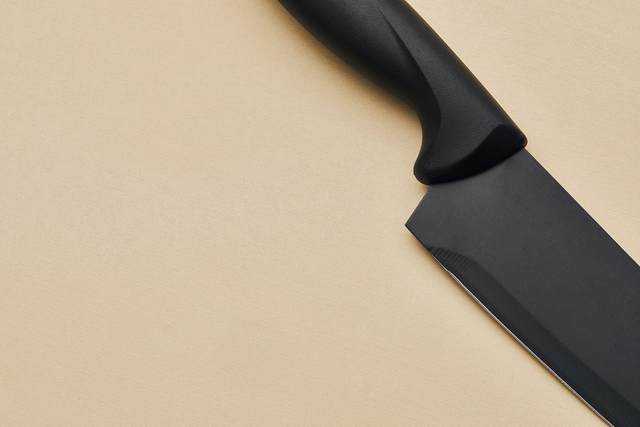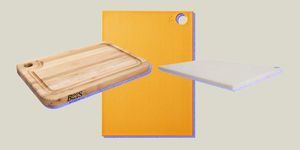You've probably used a number of different cutting boards in your life. Perhaps you had a thick, butcher block-style wooden one. Or a thin plastic one that you could easily pick up, fold up and dump out your ingredients. But according to Chef Jordan Terry of New York restaurant Dirty French, you're wasting your time on any cutting board not made out of rubber.
“This isn’t some thin, plastic malarkey. It’s a solid, beautiful and terribly functional cutting board,” he said of the three-quarter-inch-thick rubber cutting boards on sale at JB Prince. “They are just a joy to cut on,” Chef Terry said. The chef went on to say that rubber cutting boards are better than wood and plastic cutting boards, as they have the upper hand in nearly every category. How could that be? Here’s what you need to know (along with some of our recommended rubber cutting boards).
-
 NoTrax Sani-Tuff Read More
NoTrax Sani-Tuff Read More -
 Yoshihiro Hi-Soft Read More
Yoshihiro Hi-Soft Read More -
 Hasegawa Read More
Hasegawa Read More -
 Asahi Rubber Cutting Board Read More
Asahi Rubber Cutting Board Read More
Benefits of a Rubber Cutting Board
Longer Lasting Edges
The base function of a cutting board is to provide a surface to piece apart food that won’t damage your knife, not to protect surfaces from your knife. Chopping onions on a granite countertop is odd and dangerous to a blade’s integrity. Plastic boards are too hard, still, and some wood boards are too tough (bamboo in particular). Rubber boards absorb knife strokes instead of fighting back against them. This means the edge on your knife will last longer and won’t require as much honing and sharpening in the long run.
Heavy Duty
Rubber cutting boards are meant to stay put. Where a 12″ x 24″ plastic board may weigh around half a pound, a rubber board of the same dimensions will be close to five pounds. This added weight — and thickness, depending on what you buy — means warping is less likely (high heat situations are the only real risk) and the board won’t be going anywhere while you're slicing and dicing.
Easier Cleanup
Plastic boards win the clean-up round by way of dishwasher-safe materials but lose every other round. But rubber boards have an advantage over wood boards in one key area — they don’t need to be oiled. If you don’t oil a wood board, it will become brittle and crack. Rubber boards only require a quick soap-and-water hand wash and they’re good to go.
Time-Tested
Knife-friendliness and longevity are where rubber and wood boards separate themselves from plastic. After months of abuse, all cutting boards will have gashes, stains and divets all over them. Rubber and wood boards can sand those away with ease. Rubber can even be sanded by sans-machine.
The One Big Downside: No Dishwashers
Though some rubber cutting boards suggest machine washing won't damage them, tread lightly with it. The heat of a dishwasher can warp rubber boards, which do not become unwarped. There is nothing worse than ruining a good tool due to negligence. Thankfully, because rubber isn't as porous as wood or plastic, they clean very easily.
NoTrax Sani-Tuff
- Size: 24"L x 18"W
- Thickness: 0.75"
Because they’re favored more in Japan than Stateside, rubber boards are typically pricier and harder to find than their wood or plastic counterparts. Sani-Tuff boards are the exception. Made in the US and almost always under $100, its antimicrobial cutting boards are National Sanitation Foundation-certified (NSF) and come in various sizes and thicknesses. These are solid blocks of rubber and require handwashing.
Yoshihiro Hi-Soft
- Size: 15.8"L x 8.8"W (Medium)
- Thickness: 0.8" (Medium)
The most available Japanese-made rubber boards are made by a company famous for its high-carbon steel knives. Yoshihiro’s Hi-Soft boards are made of a polyvinyl acetate that’s softer than any wood or plastic and most rubber boards, meaning the board takes the beating instead of the knife. Like most rubber boards, you can sand (or thoroughly rub) off unsightly cut marks or stains.
Hasegawa
- Size: 23.6"L x 11.8"W (Medium)
- Thickness: 0.8" (Medium)
Hasegawa boards are the gold standard in rubber cutting boards. They’re made of a synthetic rubber that covers a wood core. The combo makes the board lighter — 1.5-inch blocks of rubber are not easy to handle — and prevents serious warping issues. The downsides are the price and availability: You’ll be hard-pressed to find a suitable Hasegawa board for under $200, and they’re only available at specialty shops and restaurant supply stores.
Asahi Rubber Cutting Board
- Size: 15"L x 8.3"W (Medium)
- Thickness: 0.5" (Medium)
As you've certainly noticed by now, rubber cutting boards don't come cheap. So, if you're looking to dip your toe into the rubber cutting board pool without dropping a large sum on an heirloom, then have a look at Asahi's offering. Sure, it may not have the cult chef following of these other brands, but it's still antimicrobial, easy on your knives and Japan-made.





























